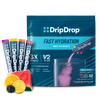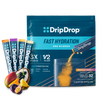Many Americans take emergency preparedness for granted and are woefully un- or under-prepared. According to the U.S. Department of Health and Human Services, 44% of Americans do not have first aid kits, while 48% do not have any emergency supplies.
You never know when a natural disaster will strike or an accident will occur. When it does, you likely won’t have time to get your supplies. You must take the time to prepare by putting together a survival kit beforehand.
In this article, we'll provide a comprehensive emergency kit list, complete with the essentials you'll want to have if you find yourself in a survival situation. This can include natural disasters, like a hurricane, or an accident happening while you are on a hiking or camping trip. Taking the time to gather and properly store these materials beforehand could one day save your life.
What Is an Emergency Kit?
An emergency kit is a pre-packed set of supplies that are ready to grab and go at a moment's notice. Generally speaking, many of the items in this survival kit will remain consistent. However, kits can vary from location to location.
What might be necessary for one location may not be so in another. For instance, if you're someone who lives in a cold climate and is worried about having to leave your home during a blizzard, you may have cold-weather essentials in your kit. Someone in Florida preparing for a hurricane probably wouldn't be worried about having a sleeping bag rated for sub-zero temperatures.
Your emergency kit should, at a minimum, have enough materials to last at least three days, according to Ready.gov. This goes for all members of your family.
Why Assemble an Emergency Kit?
When disaster strikes, things quickly become chaotic. You may lose connection with the outside world. Your home may lose electricity. Cell phone towers may go down, making it tougher to receive notices from local officials. In the case of an emergency, you may be forced to act in a matter of minutes.
Situations in which you may find yourself needing an emergency kit include:
- Weather-related scenarios, such as hurricanes, floods, blizzards, wildfires, and earthquakes
- Home-related incidents such as a fire
- Situations where you're outdoors for extended periods, such as a hiking or camping trip
Your kit should be pre-packed in a backpack or similar bag so that you can grab it easily and go. It should be something that you can take with you, either by foot or in a car.
Coming Up With a Plan of Action
Before you can start building your emergency kit, you'll want to sit down with your family and loved ones to start crafting an action plan.
Start by asking yourself what are the possible emergencies that could occur in your area. From there, begin formulating an emergency plan that all family members can follow. This action plan could vary depending on the situation.
For instance, in the case of flooding, you may want all family members to meet in the garage. However, if there were a house fire, this would not be a feasible plan. Instead, you may want all family members to meet at a specific tree in your neighbor's yard. You may also want to come up with an evacuation route, in case you need to leave your home.
Some questions that you can ask yourself to help formulate your disaster plan:
- How will we evaluate the home if necessary?
- If not everyone is home at the time of the emergency, where will we meet?
- What route will we take to leave our town in case of an emergency? Is there an alternative route in case certain roads are blocked?
- What warning signs do we need to listen for?
- Who is the designated emergency contact?
- Where are we going to keep our emergency supplies?
Whatever you come up with, make sure that the plan is understood by everyone. During an emergency situation, you won't have much time to think — only to react.
Emergency Kit List
Now that you've built your emergency plan with your family, the next step is to begin compiling things you'll need in the event of an emergency. No matter where you are, you're going to want to make sure that you have these essentials.
Food and Water
The most critical component of any emergency kit is non-perishable food and water. As mentioned, you'll want at least a three-day supply if not longer. The food in your kit should not require refrigeration. It should require little water, if any, to prepare. Examples include:
- Canned fruits and vegetables
- Dehydrated or canned meats
- Protein bars
- Peanut butter
- Nuts and crackers
- Granola and cereal
- Dried fruit
You're also going to want to include a manual can opener, paper towels, and utensils.
You'll want everyone to also have at least a gallon of water per day. Those with unique health needs, such as nursing mothers, may need more. Additionally, those in warm or humid climates may want to consider bringing more water. This water is not only for drinking but also for things like personal hygiene and cooking. Having at least a gallon per person should allow you to meet your basic needs while also helping to keep you hydrated.
Dehydration Remedy
While water is important, you're also going to want to make sure you have ready-to-go electrolyte packets. Water alone is not enough, especially when you're dehydrated. Dehydration occurs when the body loses more fluids than it can replace. It's often accompanied by an imbalance of electrolytes, including sodium, chloride, and potassium.
DripDrop is scientifically formulated with a medical balance of electrolytes, proven to effectively remedy mild to moderate dehydration without the need for IV therapy. It comes in individual powdered packets, making it easy to store in your emergency kit. All you need to do is add the solution to either eight or 16 ounces of water — depending on the size of the packet — to fight dehydration. The formula allows you to absorb fluid two to three times faster than plain water alone.
Why Dehydration is a Risk in Emergency Situations
Many emergency situations, including hurricanes and earthquakes, can damage infrastructure and contaminate the water supply. It can take days or weeks for a city to restore potable water. This can limit your access to drinking water and increase your risk of dehydration.
Dehydration, in turn, increases your overall risk. Research shows that with as little as 1% water loss, cognitive performance begins to decrease. This can impact your mood, motor coordination, attention, and memory. When you’re in an emergency situation, you need to be as alert as possible.
Mild to moderate dehydration can include fatigue, headache, muscle cramps, and nausea. If it becomes severe, dehydration can increase your blood pressure, shut down your kidneys, and eventually result in death.
Drinking water that contains DripDrop can help you remedy dehydration.
First Aid Kit
You never know when someone will suffer an injury, either minor or major. A first aid kit is critical to have in your survival kit. Your first aid supplies should include:
- Sterile gloves
- Dressings to stop bleeding
- Antibiotic ointments
- Ointments for burns
- Disinfectant
- Thermometer
- Both non-prescription and prescription medications
In addition to having medical supplies, you should consider taking a First Aid Training course from the American Red Cross so that you can treat — at the very least — minor injuries.
Miscellaneous Items
There are numerous other items that you may need, including:
- Duct tape
- A whistle
- Extra cell phone batteries and chargers
- Fire extinguisher
- Flares
- Hand-crank radio
- Walkie Talkies
- Scissors
- Sanitation wipes and towelettes
- Pliers or wrenches
- Sleeping bags and warm blankets
- A tent or plastic sheeting to shelter-in-place
- Extra batteries
- Matches in a waterproof container
- Personal hygiene items
- Household bleach
- Garbage bags
- Dust masks
- Eyeglasses and contact lenses
- Toilet paper
- Hand sanitizer
- Pet food and medication
Clothing
You don't want to weigh down your go bag with clothes, but you also want to make sure you're prepared for whatever is about to come your way. Each person should have at least one complete change of clothing and shoes.
This can include both short-sleeve shirts and shorts and long-sleeve shirts and pants. Depending on where you live, it can get cool at night. And even in hot climates, long-sleeve clothing can protect you from sun and bugs. Be sure to pack:
- At least one set of climate-appropriate clothing
- Long pants
- A long-sleeve shirt
- Sturdy shoes
- Rain gear
- A hat and gloves
Essential Documents
The last thing you'll need to bring is essential documents. In an emergency, you may not know when you'll be able to get back into your home if at all. Be sure to gather:
- Birth certificates
- Social Security cards
- Mortgage records
- Marriage records
- Insurance policies
- Drivers licenses
- A card with your contact information
Keep these important documents in a waterproof container to prevent damage.
Start Building Your Survival Kit Today
You never know when disaster is going to strike. Taking the time to formulate an emergency kit list can help save yours and your family's life in case of an emergency.
Start by taking the time to sit down with your family and come up with an action plan. Then buy the essentials for your supply kit, including your Drip Drop solution.
The best-case scenario is that you never have to use the emergency kit. But if a natural disaster strikes, you can rest assured that your kit is ready to go at a moment's notice.
















